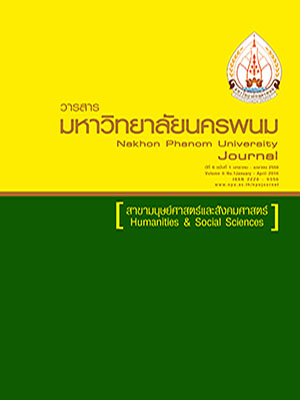ดนตรีนาเสป คณะอัลอามีน กรุงเทพมหานคร
Main Article Content
Abstract
การวิจัยครั้งนี้มีวัตถุประสงค์เพื่อ 1) ศึกษาประวัติความเป็นมาของคณะดนตรีนาเสปคณะอัลอามีน 2) ศึกษาดนตรีนาเสป ที่บรรเลงประกอบพิธีวาลีมะห์ของคณะอัลอามีน วิธีการศึกษาใช้ระเบียบการวิจัยเชิงคุณภาพ กลุ่มเป้าหมายแบ่งออกเป็น 2 กลุ่มคือ1) ผู้ทรงคุณวุฒิที่มีความรู้เกี่ยวกับประวัติความเป็นมาของชุมชนข้างสถานีรถไฟวงเวียนใหญ่ 2) บุคลากรที่มีความรู้เกี่ยวกับดนตรีในวัฒนธรรมอิสลามและประวัติความเป็นมาของคณะอัลอามีน คือ นักดนตรีในคณะจำนวน 11 คน เครื่องมือที่ใช้ในการวิจัย แบ่งออกเป็น 1) แบบสัมภาษณ์เกี่ยวกับประวัติความเป็นมาของชุมชนข้างสถานีรถไฟวงเวียนใหญ่ 2) แบบสัมภาษณ์ประวัตินักดนตรีคณะอัลอามีน 3) แบบบันทึกการสังเกตการแสดงดนตรี
ผลการวิจัยพบว่า 1) ดนตรีนาเสปของชุมชนข้างสถานีรถไฟวงเวียนใหญ่ได้รับการสืบทอดต่อกันมาในรูปแบบ มุขปาฐะผ่านคณะดนตรีนาเสปประจำชุมชนใช้ชื่อคณะว่า คณะนาเสปอัลอามีน ก่อตั้งเมื่อปี พ.ศ. 2522 และได้สืบทอดมาจนถึงรุ่นเยาวชนเมื่อปี พ.ศ. 2552 2) วัฒนธรรมของชาวไทยมุสลิมที่อนุญาตให้บรรเลงดนตรีนาเสปได้คือ พิธีนิกะห์,วาลีมะห์ (พิธีแต่งงาน) พิธีเข้าสุหนัตและวันออกฮัจญี (วันออกบวช) โดยมีจุดประสงค์เพื่อให้เกิดความบันเทิงและอวยพรแก่ผู้ร่วมงาน 3) บทเพลงนาเสปของคณะอัลอามีนเป็นภาษามลายู ส่วนใหญ่อยู่ในบันไดเสียงทาง minor มีการซํ้าทำนองแต่เปลี่ยนคำร้อง นักร้องนำร้องสลับกับลูกคู่รับ รูปแบบของเพลงมีการเปลี่ยนอัตราจังหวะระหว่างเพลง ทำให้เกิดหน้าทับนาเสปใช้กับจังหวะช้าในอัตราจังหวะ 4/4 หน้าทับกาเลงใช้กับจังหวะเร็วในอัตราจังหวะ 2/4 และหน้าทับสามช่าประยุกต์เข้ากับดนตรีสมัยใหม่ ประกอบด้วย 1. รูปแบบนาเสป จังหวะช้าตลอดทั้งเพลงใช้หน้าทับนาเสป และสามช่า 2. รูปแบบกาเลง จังหวะช้าสลับเร็ว ใช้หน้าทับนาเสป และกาเลง และ 3. รูปแบบด้น จังหวะช้าสลับเร็วใน 3–4 ด้น (ท่อน) จบเพลงด้วยจังหวะเร็ว ใช้หน้าทับนาเสป และกาเลงตามลำดับ
The purposes of this study were 1) to investigate the history of Nasep Music of Al-Amin Band, 2) to examine Nasep music performed by Al-Amin Band in Thai Islamic rituals called Walimah (wedding ceremonies). The method of this study was qualitative research. The target people were divided into two groups: 1) experts with profound knowledge concerning the history of the community next to the Wong Wian Yai train station, and 2) people with knowledge about music in Islamic culture and the history of Al-Amin Band of eleven musicians. The instruments of this study consisted of: 1) an interview about the history of the community next to the Wong Wian Yai train station, 2) an interview of Al-Amin Band’s musicians concerning their profiles, and 3) a record form of the Band’s musical performance observation.
results of the study were as follows : 1) Nasep music of the community next to the Wong Wian Yai train station was inherited from the past to the present in oral form through the local band of the community called ‘Al-Amin Nasep Band’ founded in 1979 and it was handed down to Islamic youths in 2009. 2) Nasep music was performed in Thai Islamic rituals and Muslim’s auspicious ceremonies such as Nikah and Walimah (wedding ceremonies), male circumcision and Hari Raya festivals. The objectives were to entertain and bless those who attended the ceremonies. 3) The Nasep songs of Al-Amin Band were all in Malay. Most of the key signatures found in the songs were in minor scale. The melody could be repeated while the lyrics were being changed. Singing alternated between the lead vocalist and chorus. There were changes in rhythm amidst the song in the musical forms of Nasep music which made a Nasep drum slash at the low rhythm rate of 4/4. A Kaleng drum slash was at the quick rhythm rate of 2/4. The Cha Cha Cha drum slash as applied to the modern music comprised: (1) The Nasep form in which the whole song rhythm was slow by using a Nasep drum slash and a Cha Cha Cha drum slash; (2) the Kaleng form in which the slow and quick rhythms take turns with Nasep and Kaleng drum slashes: and (3) the extemporaneous rhythm form in which the slow and quick rhythms take turns in 3 to 4 extemporaneous rhythms and the song ended with a quick rhythm by using the Nasep drum slash first followed by the Kaleng drum slash respectively.


